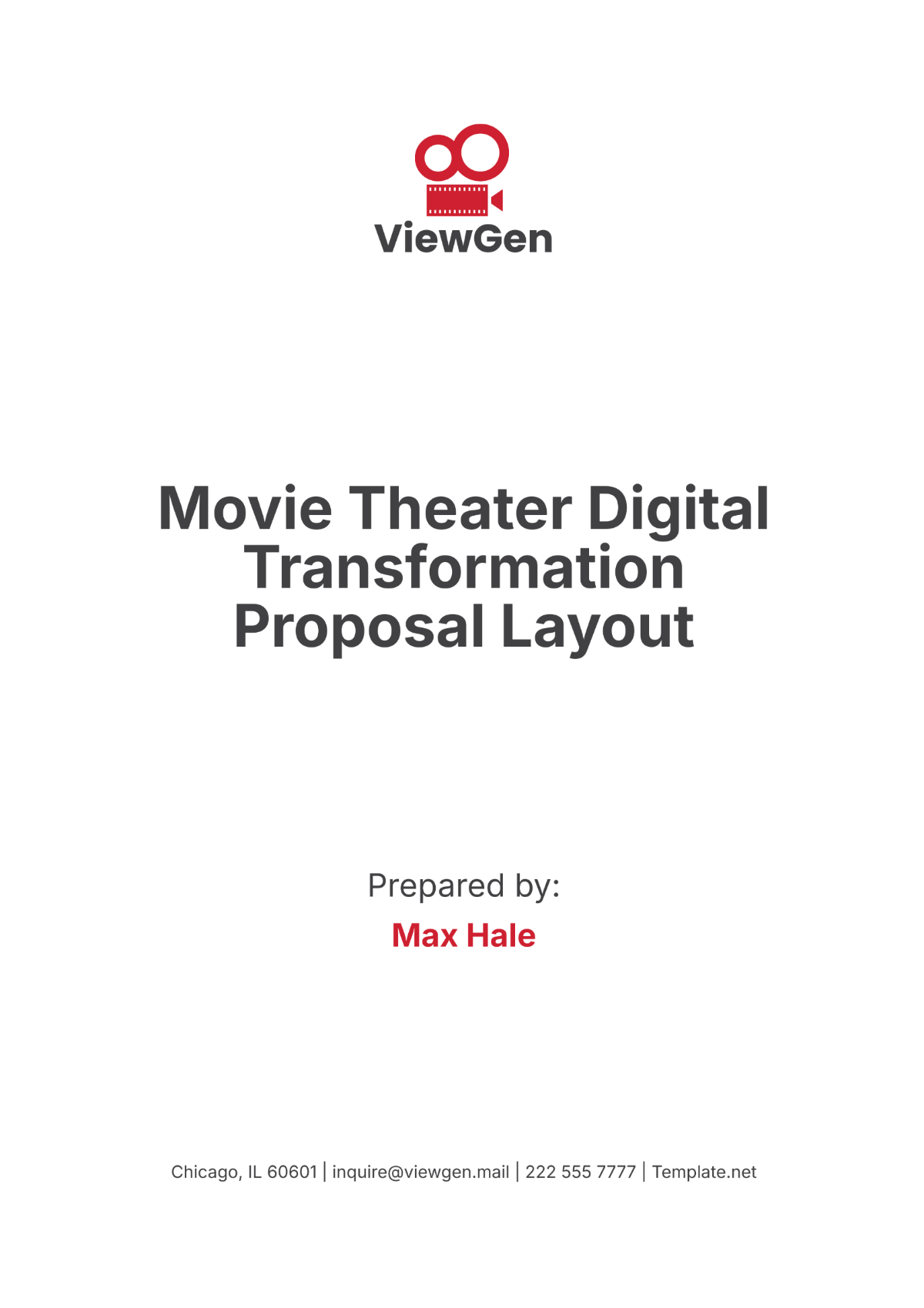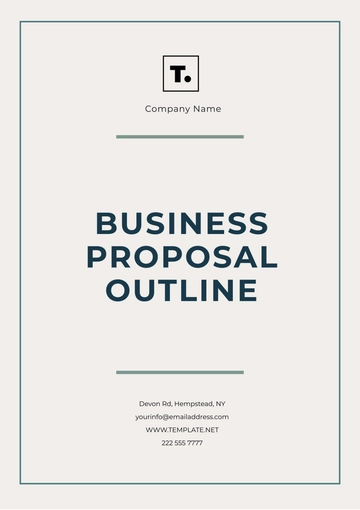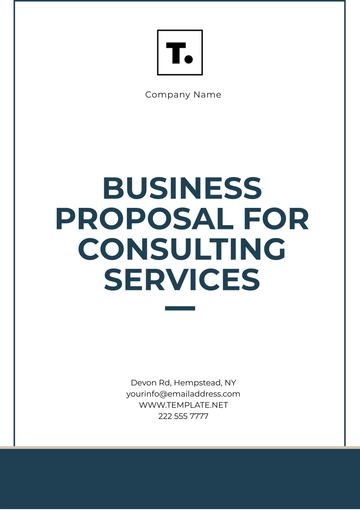Free Movie Theater Digital Transformation Proposal Layout

A. Executive Summary
1. Objective
(Clearly articulate the purpose of the digital transformation, emphasizing the need for modernization and how it aligns with the theater's strategic goals. Summarize the transformation's scope and anticipated impact.)
2. Key Benefits
(Highlight the primary advantages such as enhanced customer experience through advanced technology, improved operational efficiency with streamlined processes, and potential revenue growth driven by innovative marketing and service delivery methods.)
B. Current State Analysis
1. Overview of Current Operations
(Provide a comprehensive description of the theater’s existing operations, including current technologies, systems, and processes. Detail how these elements support or hinder daily functions.)
2. Challenges and Limitations
(Identify specific pain points and inefficiencies in the current setup. Discuss how outdated systems or processes may be affecting customer satisfaction, operational efficiency, and overall performance.)
C. Digital Transformation Strategy
1. Vision and Goals
(Define the long-term vision for the digital transformation, including how it aligns with the theater’s strategic objectives. Set specific, measurable goals to track progress and success.)
2. Key Areas of Focus
Customer Experience: (Explore enhancements such as digital ticketing solutions, mobile app integration, and personalized loyalty programs to improve guest engagement and satisfaction.)
Operational Efficiency: (Plan for the adoption of digital POS systems, advanced inventory management tools, and automated scheduling to streamline operations and reduce manual workload.)
Marketing and Sales: (Discuss strategies for leveraging data analytics, social media platforms, and targeted promotions to boost marketing efforts and increase ticket sales.)
Technology Upgrades: (Outline plans for modernizing projection and sound systems, upgrading in-theater technology, and incorporating advanced visual and audio enhancements.)
D. Implementation Plan
Phase 1: Planning and Assessment
Needs Assessment: (Conduct a thorough analysis to identify specific needs and requirements for the digital transformation. Gather input from stakeholders to ensure all critical areas are addressed.)
Technology Selection: (Evaluate and select the most suitable technologies and vendors based on functionality, compatibility, and cost-effectiveness. Ensure chosen solutions align with the theater's goals.)
Phase 2: Development and Integration
System Development: (Oversee the customization and development of new software solutions to meet identified needs. Work closely with developers to ensure alignment with theater requirements.)
Integration: (Ensure seamless integration of new systems with existing infrastructure. Test integrations thoroughly to minimize disruptions and ensure smooth operation.)
Phase 3: Deployment
Rollout Strategy: (Develop a detailed plan for the phased deployment of new technologies. Schedule rollouts to minimize operational disruptions and allow for gradual adaptation.)
Training and Support: (Implement comprehensive training programs for staff to ensure effective use of new systems. Provide ongoing support to address any issues and ensure successful adoption.)
Phase 4: Evaluation and Optimization
Performance Metrics: (Define key performance indicators (KPIs) and success metrics to measure the effectiveness of the digital transformation. Monitor these metrics regularly to assess progress.)
Continuous Improvement: (Develop a plan for ongoing evaluation and refinement of the digital systems. Use feedback and performance data to make necessary adjustments and improvements.)
E. Budget and Financial Analysis
1. Cost Breakdown
(Provide a detailed budget that outlines the costs associated with technology investments, system development, training, and implementation. Include both initial and ongoing expenses.)
2. Return on Investment (ROI)
(Project the financial benefits and cost savings resulting from the digital transformation. Analyze potential revenue increases and cost reductions to justify the investment.)
3. Funding Options
(Explore various funding sources or financial arrangements to support the transformation. Consider options such as grants, loans, or budget reallocations to secure necessary resources.)
F. Risk Management
1. Risk Identification
(Identify potential risks associated with the digital transformation, such as technology failures, integration challenges, or resistance to change. Assess the likelihood and impact of each risk.)
2. Mitigation Strategies
(Develop strategies to address and minimize identified risks. Implement contingency plans and risk management practices to ensure smooth execution and address issues proactively.)
G. Conclusion
1. Summary of Benefits
(Recap the anticipated benefits of the digital transformation, including improvements in customer experience, operational efficiency, and financial performance. Reinforce the value of the proposed changes.)
2. Call to Action
(Encourage stakeholders to support and approve the proposal. Emphasize the importance of their commitment to achieving the outlined goals and driving the theater’s modernization efforts.)
H. Appendices
1. Supporting Documents
(Include any additional documents, data, or research that provide further context or support for the proposal. This may include case studies, market research, or detailed technical specifications.)
2. Technology Vendor Profiles
(Provide information about selected technology vendors or solutions, including their profiles, capabilities, and relevance to the theater’s needs. This helps stakeholders understand the basis for technology choices.)
- 100% Customizable, free editor
- Access 1 Million+ Templates, photo’s & graphics
- Download or share as a template
- Click and replace photos, graphics, text, backgrounds
- Resize, crop, AI write & more
- Access advanced editor
Transform your theater with the Movie Theater Digital Transformation Proposal Layout Template from Template.net. This fully customizable and editable template is perfect for outlining your digital strategy. Easily editable in our Ai Editor Tool, it allows you to personalize every aspect, ensuring a professional and comprehensive proposal.
You may also like
- Business Proposal
- Research Proposal
- Proposal Request
- Project Proposal
- Grant Proposal
- Photography Proposal
- Job Proposal
- Budget Proposal
- Marketing Proposal
- Branding Proposal
- Advertising Proposal
- Sales Proposal
- Startup Proposal
- Event Proposal
- Creative Proposal
- Restaurant Proposal
- Blank Proposal
- One Page Proposal
- Proposal Report
- IT Proposal
- Non Profit Proposal
- Training Proposal
- Construction Proposal
- School Proposal
- Cleaning Proposal
- Contract Proposal
- HR Proposal
- Travel Agency Proposal
- Small Business Proposal
- Investment Proposal
- Bid Proposal
- Retail Business Proposal
- Sponsorship Proposal
- Academic Proposal
- Partnership Proposal
- Work Proposal
- Agency Proposal
- University Proposal
- Accounting Proposal
- Real Estate Proposal
- Hotel Proposal
- Product Proposal
- Advertising Agency Proposal
- Development Proposal
- Loan Proposal
- Website Proposal
- Nursing Home Proposal
- Financial Proposal
- Salon Proposal
- Freelancer Proposal
- Funding Proposal
- Work from Home Proposal
- Company Proposal
- Consulting Proposal
- Educational Proposal
- Construction Bid Proposal
- Interior Design Proposal
- New Product Proposal
- Sports Proposal
- Corporate Proposal
- Food Proposal
- Property Proposal
- Maintenance Proposal
- Purchase Proposal
- Rental Proposal
- Recruitment Proposal
- Social Media Proposal
- Travel Proposal
- Trip Proposal
- Software Proposal
- Conference Proposal
- Graphic Design Proposal
- Law Firm Proposal
- Medical Proposal
- Music Proposal
- Pricing Proposal
- SEO Proposal
- Strategy Proposal
- Technical Proposal
- Coaching Proposal
- Ecommerce Proposal
- Fundraising Proposal
- Landscaping Proposal
- Charity Proposal
- Contractor Proposal
- Exhibition Proposal
- Art Proposal
- Mobile Proposal
- Equipment Proposal
- Student Proposal
- Engineering Proposal
- Business Proposal





























